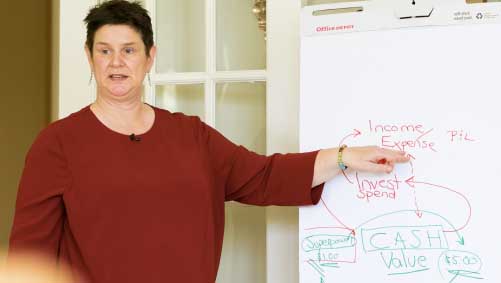
Today we’re talking about the big bad T-word: TAXES.
This is going to be a very quick tip on how to minimize what is very likely (in the early days) the biggest expense in your business once you become profitable.
One of the reasons my clients come to me is April comes around and they have a surprise tax bill.
It happens when they become profitable for the first time, usually in the third year of a successful start-up.
And this is incredibly awkward because they are in the middle of celebrating a fantastic year, yet find out that they don’t have enough cash to pay their tax bill.
Once a business is profitable, don’t miss this: Taxes are one of the biggest expenses in your business.
It can be embarrassing to get to April without the cash to pay your taxes.
So let’s tackle a couple of steps to be sure this doesn’t happen to YOU.
Predicting Your Numbers
You can (and should) do this exercise a couple of times during each year:
- Know what your net income is so far this year
- Make a guess at what you think your total net income will be for the whole year
Now “Net Income” is simply the money you make less the money you spend in a year.
Yes! That simple.
If you aren’t keeping track of that as you go through the year – and you are currently profitable – this is a great reason to get the process in place to do so.
Let’s look at a simple example:
It’s October of 2022, and you know how much money you’ve made this year (because you keep track of it monthly in QuickBooks, or Excel, or Xero, or some other brilliant system). You also know how much money you’ve spent so far this year (for the same reason).
In addition, you know what it is that drives how much money you make (how many things you sell times how much you sell them for). And you have a pretty good history of how much money you spend each month from January through October.
How do you predict these same numbers for November and December so that you can see what your totals will be by year-end?
So don’t get fancy here!
- If your business is growing and isn’t affected by the holiday season — assume that November and December sales will be higher than they’ve been the last few months.
- If you typically have a seasonal downturn — assume that the November and December sales will be lower than the last few months.
- If things tend to stay pretty steady in your business — assume November and December will look exactly like October.
Here is that example with some specific numbers, assuming that your business has been growing steadily for the last 6 months (and there’s no reason to expect that it won’t continue to grow).
Let’s say that:
- From January – October, your AVERAGE MONTHLY REVENUE has been $10,000 per month
- From January – October, your AVERAGE MONTHLY EXPENSES have been $ 6,000 per month
Jan – Oct Revenue = $100,000 ($10,000 x 10 months)
Nov – Dec Revenue = $20,000 (estimating $10,000 x 2 months)
TOTAL YEAR REVENUE = $120,000
Jan – Oct Expenses = $60,000 ($6,000 x 10 months)
Nov – Dec Expenses = $12,000 ($6,000 x 2 months)
TOTAL YEAR EXPENSES = $72,000
Now it’s easy – you take the total year revenue ($120,000) minus the total year expenses ($72,000), and at this point it looks like your full year taxable income will be $48,000.
THAT is the number you take to your tax accountant BEFORE YEAR END to ask them what you can do to make your income tax come in at the lowest possible amount.
One of my current clients did just this; he had a massive Kickstarter campaign, and a whole bunch of cash came in to the business as a result.
His product would be distributed to the supporters by the end of the current year.
So, in short, he is going to make a ton of money in the business this year, and the goal is to keep as much of that money as possible in the business (and even more importantly, be sure that we have enough money in the bank to cover whatever that tax bill turns out to be).
Let’s make sure TAXES don’t bite the very year that you’re celebrating profitability.
Apply the formula above anytime during the year to keep a good eye on this potential pitfall and turn it into an opportunity.

Author, Virtual CFO, and Finance Coach
“Your First CFO: The Accounting Cure for Small Business Owners” on AMAZON






